Analysis of Leadership and Management Roles in Toyota Operations
VerifiedAdded on 2020/10/22
|18
|5152
|117
Report
AI Summary
This report provides a detailed analysis of leadership and management practices within Toyota's operations. It begins with an introduction to operations management and the importance of balancing costs and revenue, using Toyota as a case study. The report then delves into the roles and characteristics of leaders and managers within Toyota, differentiating between their responsibilities and highlighting the impact of divisional organizational structure. It explores various leadership theories, including transformational, classical, trait, and charismatic leadership, and their application within the company. The report further examines the roles of leaders and managers in critical business situations, such as conflict resolution and time management, providing examples of how these are handled within Toyota. It discusses the application of scientific and behavioral management theories. The report also analyzes different leadership approaches like situational and contingency leadership theories. Finally, the report covers the key approaches to operations management, the value of operations management in achieving business objectives, and factors impacting operational management and decision-making within Toyota's business environment.
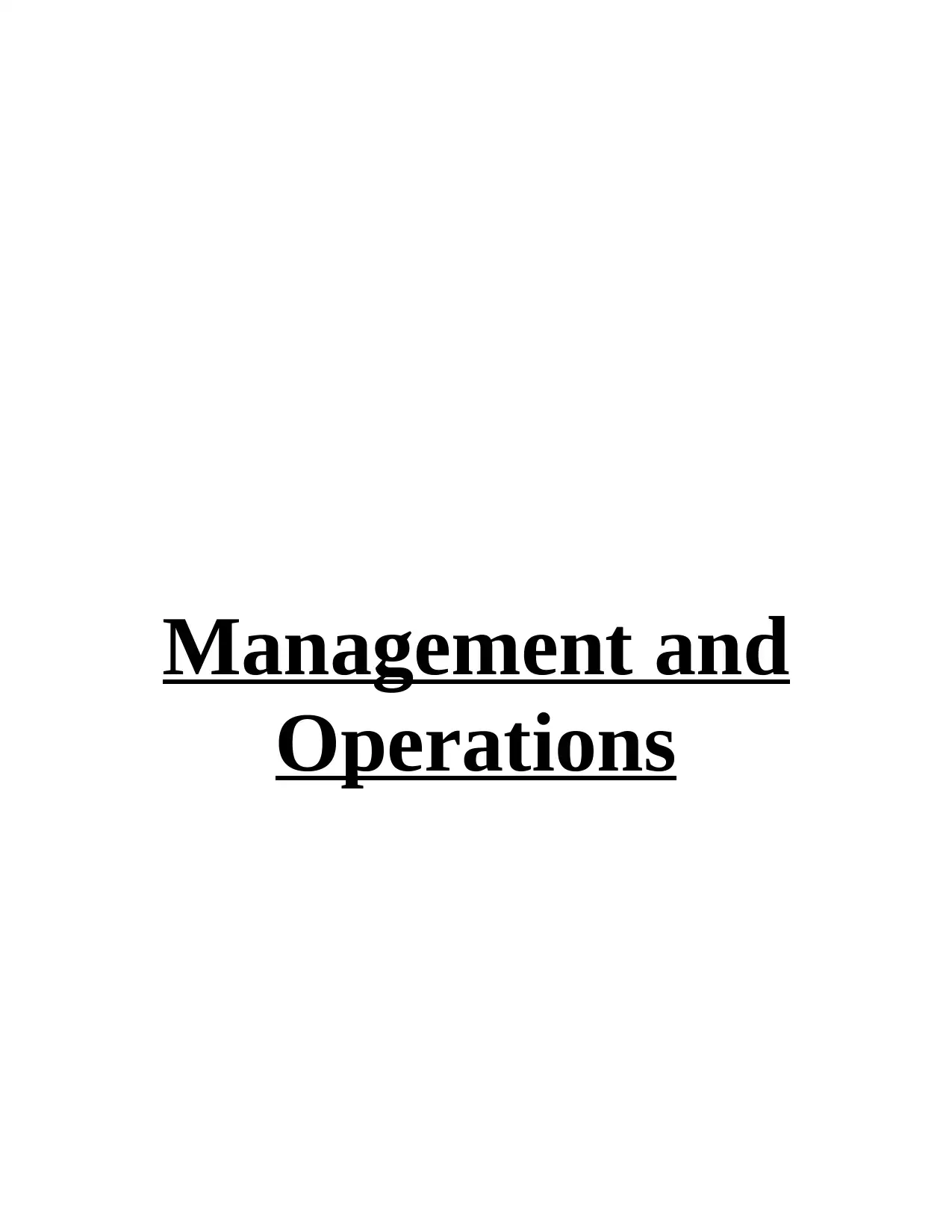
Management and
Operations
Operations
Paraphrase This Document
Need a fresh take? Get an instant paraphrase of this document with our AI Paraphraser

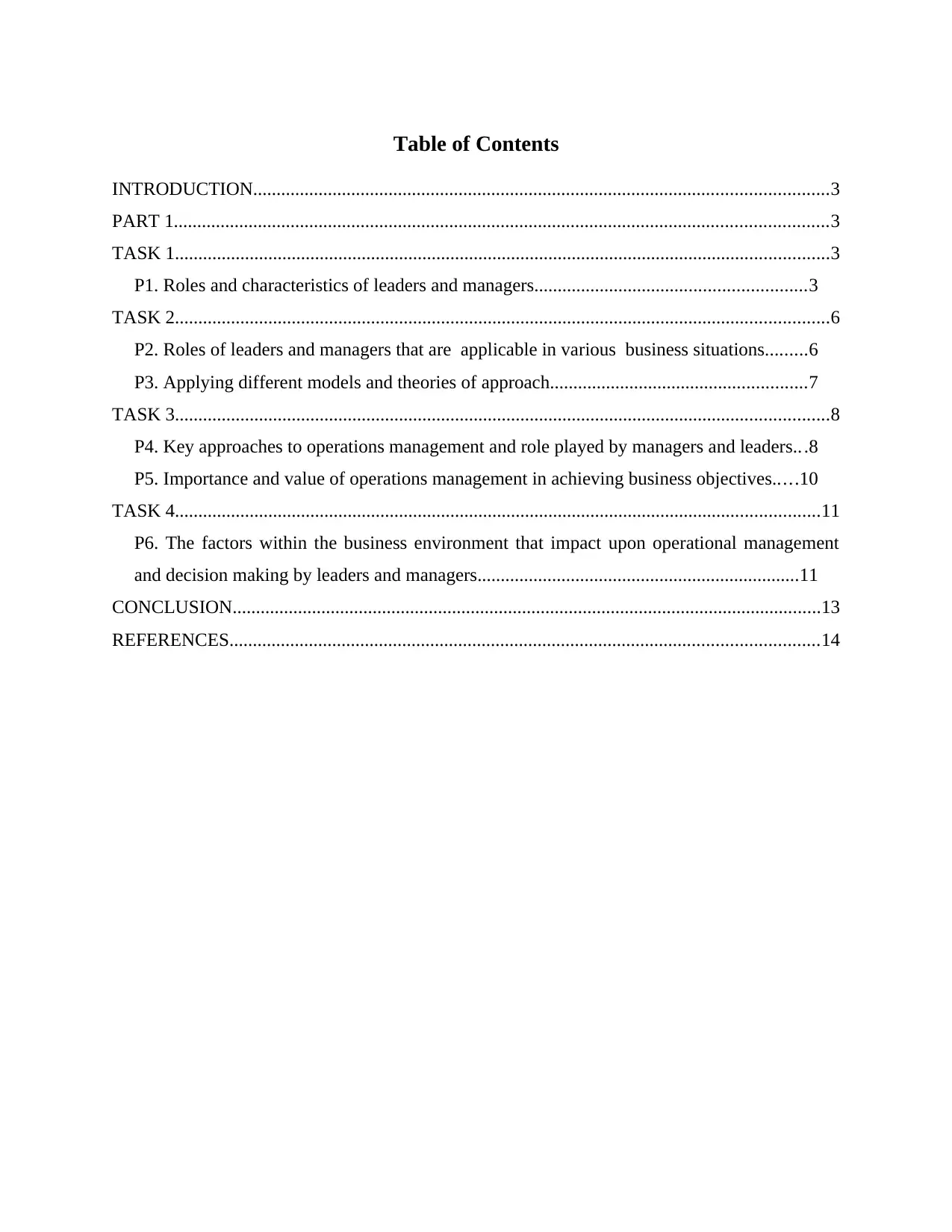
Table of Contents
INTRODUCTION...........................................................................................................................3
PART 1............................................................................................................................................3
TASK 1............................................................................................................................................3
P1. Roles and characteristics of leaders and managers..........................................................3
TASK 2............................................................................................................................................6
P2. Roles of leaders and managers that are applicable in various business situations.........6
P3. Applying different models and theories of approach.......................................................7
TASK 3............................................................................................................................................8
P4. Key approaches to operations management and role played by managers and leaders...8
P5. Importance and value of operations management in achieving business objectives.....10
TASK 4..........................................................................................................................................11
P6. The factors within the business environment that impact upon operational management
and decision making by leaders and managers.....................................................................11
CONCLUSION..............................................................................................................................13
REFERENCES..............................................................................................................................14
INTRODUCTION...........................................................................................................................3
PART 1............................................................................................................................................3
TASK 1............................................................................................................................................3
P1. Roles and characteristics of leaders and managers..........................................................3
TASK 2............................................................................................................................................6
P2. Roles of leaders and managers that are applicable in various business situations.........6
P3. Applying different models and theories of approach.......................................................7
TASK 3............................................................................................................................................8
P4. Key approaches to operations management and role played by managers and leaders...8
P5. Importance and value of operations management in achieving business objectives.....10
TASK 4..........................................................................................................................................11
P6. The factors within the business environment that impact upon operational management
and decision making by leaders and managers.....................................................................11
CONCLUSION..............................................................................................................................13
REFERENCES..............................................................................................................................14
⊘ This is a preview!⊘
Do you want full access?
Subscribe today to unlock all pages.

Trusted by 1+ million students worldwide
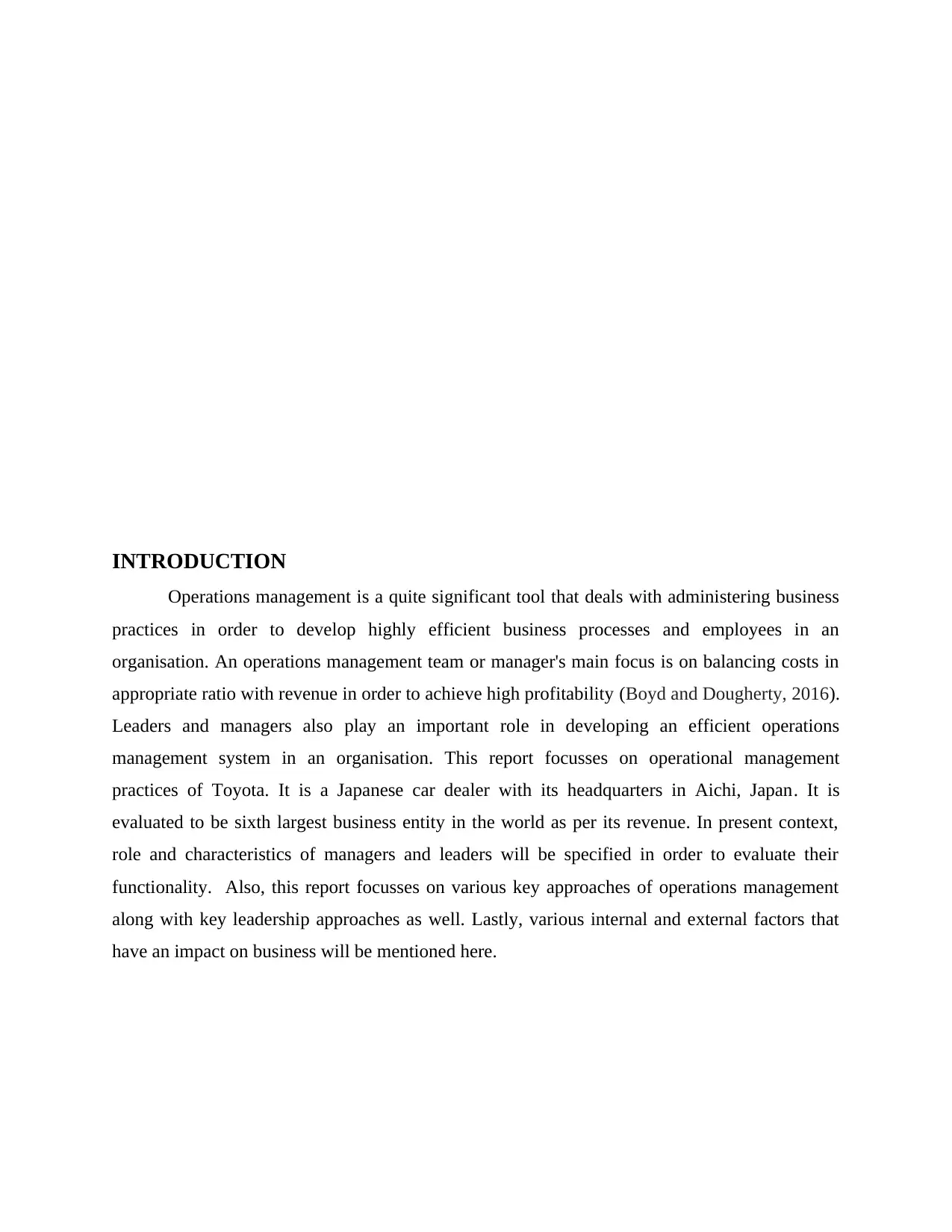
INTRODUCTION
Operations management is a quite significant tool that deals with administering business
practices in order to develop highly efficient business processes and employees in an
organisation. An operations management team or manager's main focus is on balancing costs in
appropriate ratio with revenue in order to achieve high profitability (Boyd and Dougherty, 2016).
Leaders and managers also play an important role in developing an efficient operations
management system in an organisation. This report focusses on operational management
practices of Toyota. It is a Japanese car dealer with its headquarters in Aichi, Japan. It is
evaluated to be sixth largest business entity in the world as per its revenue. In present context,
role and characteristics of managers and leaders will be specified in order to evaluate their
functionality. Also, this report focusses on various key approaches of operations management
along with key leadership approaches as well. Lastly, various internal and external factors that
have an impact on business will be mentioned here.
Operations management is a quite significant tool that deals with administering business
practices in order to develop highly efficient business processes and employees in an
organisation. An operations management team or manager's main focus is on balancing costs in
appropriate ratio with revenue in order to achieve high profitability (Boyd and Dougherty, 2016).
Leaders and managers also play an important role in developing an efficient operations
management system in an organisation. This report focusses on operational management
practices of Toyota. It is a Japanese car dealer with its headquarters in Aichi, Japan. It is
evaluated to be sixth largest business entity in the world as per its revenue. In present context,
role and characteristics of managers and leaders will be specified in order to evaluate their
functionality. Also, this report focusses on various key approaches of operations management
along with key leadership approaches as well. Lastly, various internal and external factors that
have an impact on business will be mentioned here.
Paraphrase This Document
Need a fresh take? Get an instant paraphrase of this document with our AI Paraphraser
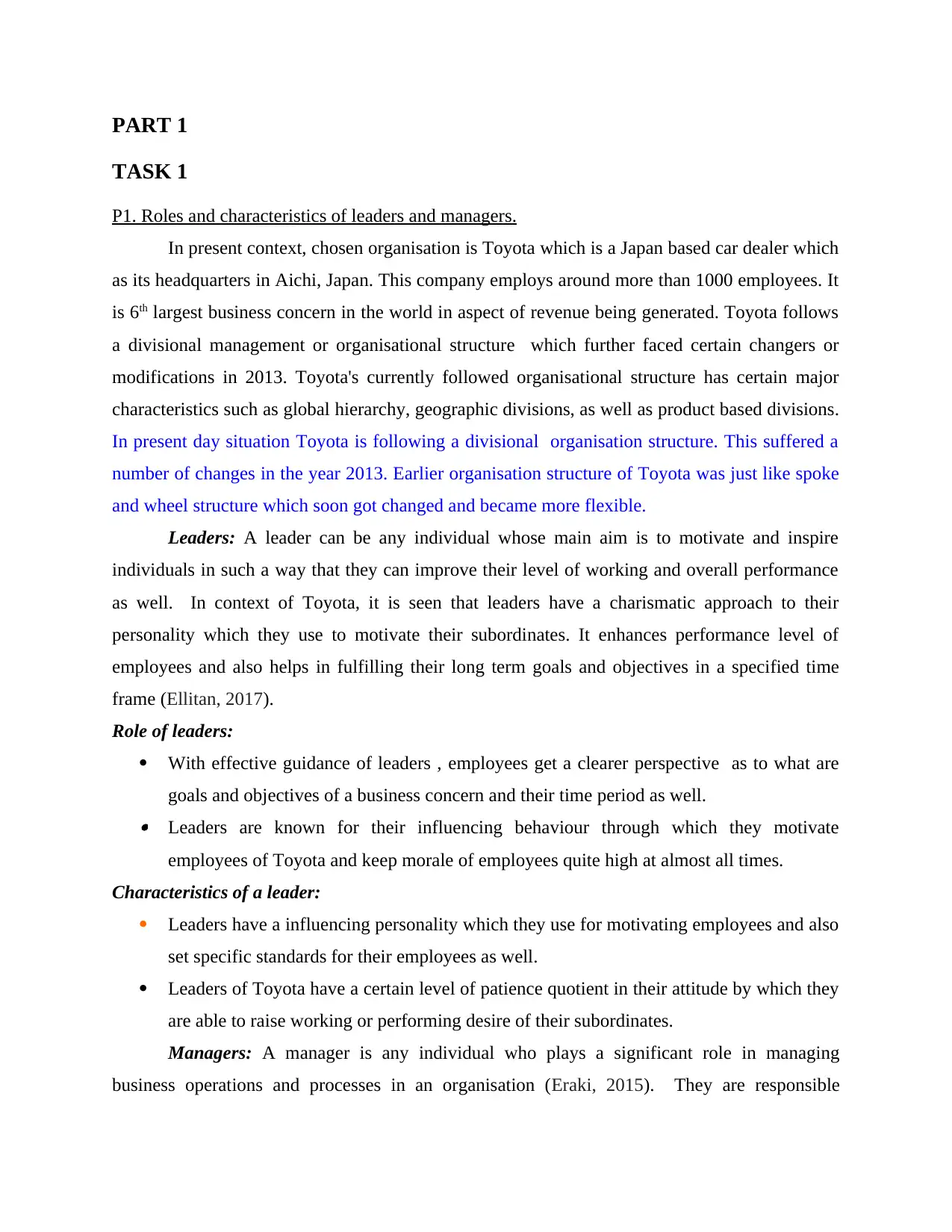
PART 1
TASK 1
P1. Roles and characteristics of leaders and managers.
In present context, chosen organisation is Toyota which is a Japan based car dealer which
as its headquarters in Aichi, Japan. This company employs around more than 1000 employees. It
is 6th largest business concern in the world in aspect of revenue being generated. Toyota follows
a divisional management or organisational structure which further faced certain changers or
modifications in 2013. Toyota's currently followed organisational structure has certain major
characteristics such as global hierarchy, geographic divisions, as well as product based divisions.
In present day situation Toyota is following a divisional organisation structure. This suffered a
number of changes in the year 2013. Earlier organisation structure of Toyota was just like spoke
and wheel structure which soon got changed and became more flexible.
Leaders: A leader can be any individual whose main aim is to motivate and inspire
individuals in such a way that they can improve their level of working and overall performance
as well. In context of Toyota, it is seen that leaders have a charismatic approach to their
personality which they use to motivate their subordinates. It enhances performance level of
employees and also helps in fulfilling their long term goals and objectives in a specified time
frame (Ellitan, 2017).
Role of leaders:
With effective guidance of leaders , employees get a clearer perspective as to what are
goals and objectives of a business concern and their time period as well. Leaders are known for their influencing behaviour through which they motivate
employees of Toyota and keep morale of employees quite high at almost all times.
Characteristics of a leader:
Leaders have a influencing personality which they use for motivating employees and also
set specific standards for their employees as well.
Leaders of Toyota have a certain level of patience quotient in their attitude by which they
are able to raise working or performing desire of their subordinates.
Managers: A manager is any individual who plays a significant role in managing
business operations and processes in an organisation (Eraki, 2015). They are responsible
TASK 1
P1. Roles and characteristics of leaders and managers.
In present context, chosen organisation is Toyota which is a Japan based car dealer which
as its headquarters in Aichi, Japan. This company employs around more than 1000 employees. It
is 6th largest business concern in the world in aspect of revenue being generated. Toyota follows
a divisional management or organisational structure which further faced certain changers or
modifications in 2013. Toyota's currently followed organisational structure has certain major
characteristics such as global hierarchy, geographic divisions, as well as product based divisions.
In present day situation Toyota is following a divisional organisation structure. This suffered a
number of changes in the year 2013. Earlier organisation structure of Toyota was just like spoke
and wheel structure which soon got changed and became more flexible.
Leaders: A leader can be any individual whose main aim is to motivate and inspire
individuals in such a way that they can improve their level of working and overall performance
as well. In context of Toyota, it is seen that leaders have a charismatic approach to their
personality which they use to motivate their subordinates. It enhances performance level of
employees and also helps in fulfilling their long term goals and objectives in a specified time
frame (Ellitan, 2017).
Role of leaders:
With effective guidance of leaders , employees get a clearer perspective as to what are
goals and objectives of a business concern and their time period as well. Leaders are known for their influencing behaviour through which they motivate
employees of Toyota and keep morale of employees quite high at almost all times.
Characteristics of a leader:
Leaders have a influencing personality which they use for motivating employees and also
set specific standards for their employees as well.
Leaders of Toyota have a certain level of patience quotient in their attitude by which they
are able to raise working or performing desire of their subordinates.
Managers: A manager is any individual who plays a significant role in managing
business operations and processes in an organisation (Eraki, 2015). They are responsible
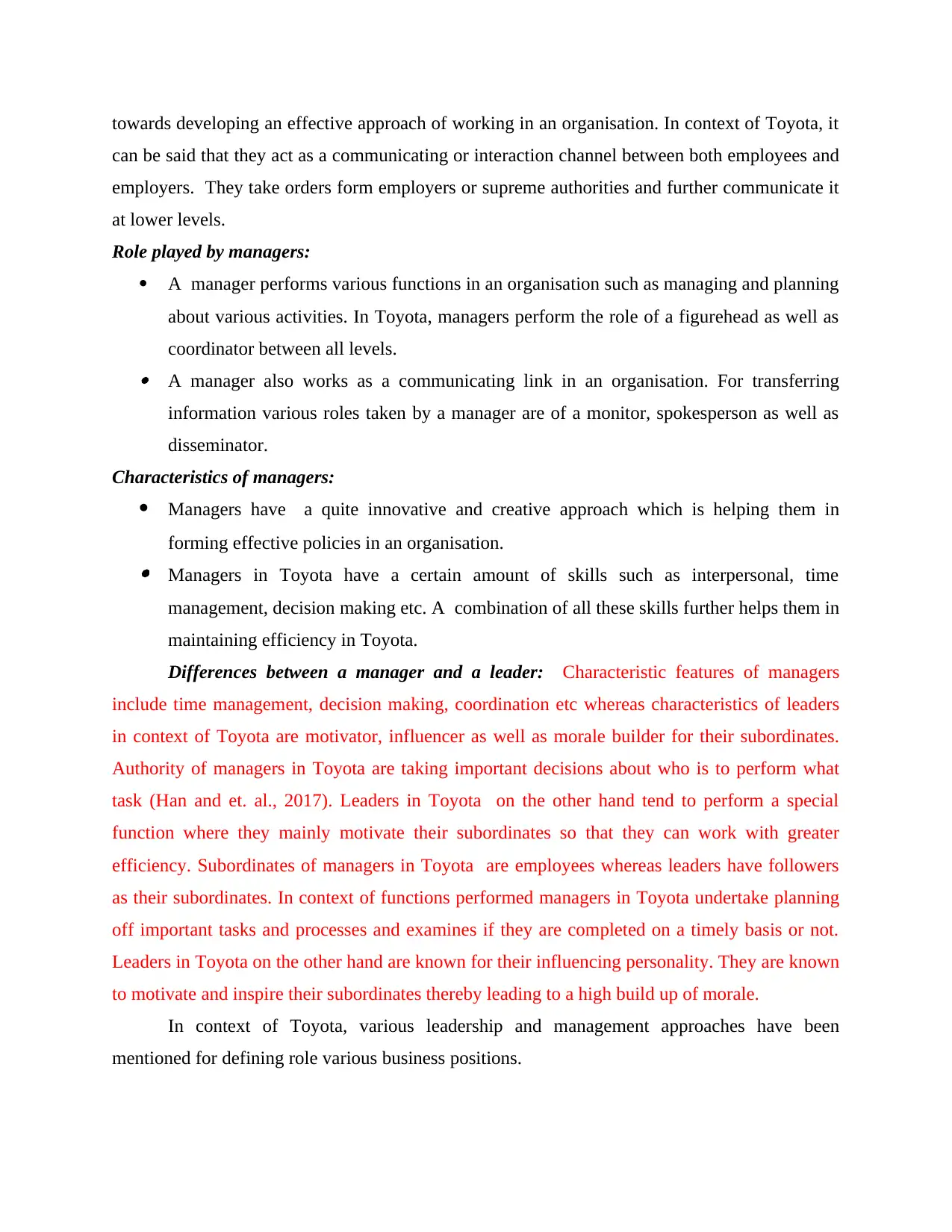
towards developing an effective approach of working in an organisation. In context of Toyota, it
can be said that they act as a communicating or interaction channel between both employees and
employers. They take orders form employers or supreme authorities and further communicate it
at lower levels.
Role played by managers:
A manager performs various functions in an organisation such as managing and planning
about various activities. In Toyota, managers perform the role of a figurehead as well as
coordinator between all levels. A manager also works as a communicating link in an organisation. For transferring
information various roles taken by a manager are of a monitor, spokesperson as well as
disseminator.
Characteristics of managers:
Managers have a quite innovative and creative approach which is helping them in
forming effective policies in an organisation. Managers in Toyota have a certain amount of skills such as interpersonal, time
management, decision making etc. A combination of all these skills further helps them in
maintaining efficiency in Toyota.
Differences between a manager and a leader: Characteristic features of managers
include time management, decision making, coordination etc whereas characteristics of leaders
in context of Toyota are motivator, influencer as well as morale builder for their subordinates.
Authority of managers in Toyota are taking important decisions about who is to perform what
task (Han and et. al., 2017). Leaders in Toyota on the other hand tend to perform a special
function where they mainly motivate their subordinates so that they can work with greater
efficiency. Subordinates of managers in Toyota are employees whereas leaders have followers
as their subordinates. In context of functions performed managers in Toyota undertake planning
off important tasks and processes and examines if they are completed on a timely basis or not.
Leaders in Toyota on the other hand are known for their influencing personality. They are known
to motivate and inspire their subordinates thereby leading to a high build up of morale.
In context of Toyota, various leadership and management approaches have been
mentioned for defining role various business positions.
can be said that they act as a communicating or interaction channel between both employees and
employers. They take orders form employers or supreme authorities and further communicate it
at lower levels.
Role played by managers:
A manager performs various functions in an organisation such as managing and planning
about various activities. In Toyota, managers perform the role of a figurehead as well as
coordinator between all levels. A manager also works as a communicating link in an organisation. For transferring
information various roles taken by a manager are of a monitor, spokesperson as well as
disseminator.
Characteristics of managers:
Managers have a quite innovative and creative approach which is helping them in
forming effective policies in an organisation. Managers in Toyota have a certain amount of skills such as interpersonal, time
management, decision making etc. A combination of all these skills further helps them in
maintaining efficiency in Toyota.
Differences between a manager and a leader: Characteristic features of managers
include time management, decision making, coordination etc whereas characteristics of leaders
in context of Toyota are motivator, influencer as well as morale builder for their subordinates.
Authority of managers in Toyota are taking important decisions about who is to perform what
task (Han and et. al., 2017). Leaders in Toyota on the other hand tend to perform a special
function where they mainly motivate their subordinates so that they can work with greater
efficiency. Subordinates of managers in Toyota are employees whereas leaders have followers
as their subordinates. In context of functions performed managers in Toyota undertake planning
off important tasks and processes and examines if they are completed on a timely basis or not.
Leaders in Toyota on the other hand are known for their influencing personality. They are known
to motivate and inspire their subordinates thereby leading to a high build up of morale.
In context of Toyota, various leadership and management approaches have been
mentioned for defining role various business positions.
⊘ This is a preview!⊘
Do you want full access?
Subscribe today to unlock all pages.

Trusted by 1+ million students worldwide
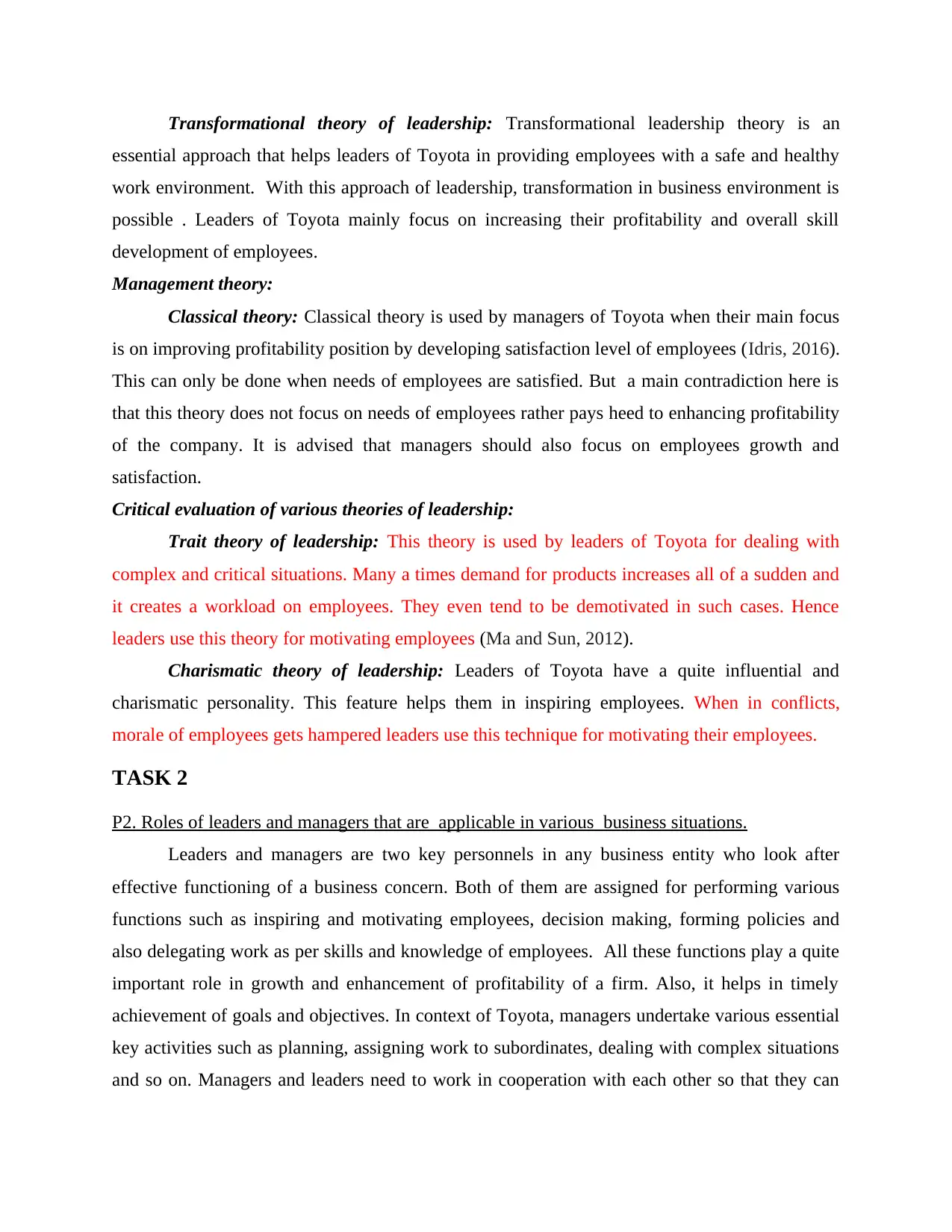
Transformational theory of leadership: Transformational leadership theory is an
essential approach that helps leaders of Toyota in providing employees with a safe and healthy
work environment. With this approach of leadership, transformation in business environment is
possible . Leaders of Toyota mainly focus on increasing their profitability and overall skill
development of employees.
Management theory:
Classical theory: Classical theory is used by managers of Toyota when their main focus
is on improving profitability position by developing satisfaction level of employees (Idris, 2016).
This can only be done when needs of employees are satisfied. But a main contradiction here is
that this theory does not focus on needs of employees rather pays heed to enhancing profitability
of the company. It is advised that managers should also focus on employees growth and
satisfaction.
Critical evaluation of various theories of leadership:
Trait theory of leadership: This theory is used by leaders of Toyota for dealing with
complex and critical situations. Many a times demand for products increases all of a sudden and
it creates a workload on employees. They even tend to be demotivated in such cases. Hence
leaders use this theory for motivating employees (Ma and Sun, 2012).
Charismatic theory of leadership: Leaders of Toyota have a quite influential and
charismatic personality. This feature helps them in inspiring employees. When in conflicts,
morale of employees gets hampered leaders use this technique for motivating their employees.
TASK 2
P2. Roles of leaders and managers that are applicable in various business situations.
Leaders and managers are two key personnels in any business entity who look after
effective functioning of a business concern. Both of them are assigned for performing various
functions such as inspiring and motivating employees, decision making, forming policies and
also delegating work as per skills and knowledge of employees. All these functions play a quite
important role in growth and enhancement of profitability of a firm. Also, it helps in timely
achievement of goals and objectives. In context of Toyota, managers undertake various essential
key activities such as planning, assigning work to subordinates, dealing with complex situations
and so on. Managers and leaders need to work in cooperation with each other so that they can
essential approach that helps leaders of Toyota in providing employees with a safe and healthy
work environment. With this approach of leadership, transformation in business environment is
possible . Leaders of Toyota mainly focus on increasing their profitability and overall skill
development of employees.
Management theory:
Classical theory: Classical theory is used by managers of Toyota when their main focus
is on improving profitability position by developing satisfaction level of employees (Idris, 2016).
This can only be done when needs of employees are satisfied. But a main contradiction here is
that this theory does not focus on needs of employees rather pays heed to enhancing profitability
of the company. It is advised that managers should also focus on employees growth and
satisfaction.
Critical evaluation of various theories of leadership:
Trait theory of leadership: This theory is used by leaders of Toyota for dealing with
complex and critical situations. Many a times demand for products increases all of a sudden and
it creates a workload on employees. They even tend to be demotivated in such cases. Hence
leaders use this theory for motivating employees (Ma and Sun, 2012).
Charismatic theory of leadership: Leaders of Toyota have a quite influential and
charismatic personality. This feature helps them in inspiring employees. When in conflicts,
morale of employees gets hampered leaders use this technique for motivating their employees.
TASK 2
P2. Roles of leaders and managers that are applicable in various business situations.
Leaders and managers are two key personnels in any business entity who look after
effective functioning of a business concern. Both of them are assigned for performing various
functions such as inspiring and motivating employees, decision making, forming policies and
also delegating work as per skills and knowledge of employees. All these functions play a quite
important role in growth and enhancement of profitability of a firm. Also, it helps in timely
achievement of goals and objectives. In context of Toyota, managers undertake various essential
key activities such as planning, assigning work to subordinates, dealing with complex situations
and so on. Managers and leaders need to work in cooperation with each other so that they can
Paraphrase This Document
Need a fresh take? Get an instant paraphrase of this document with our AI Paraphraser
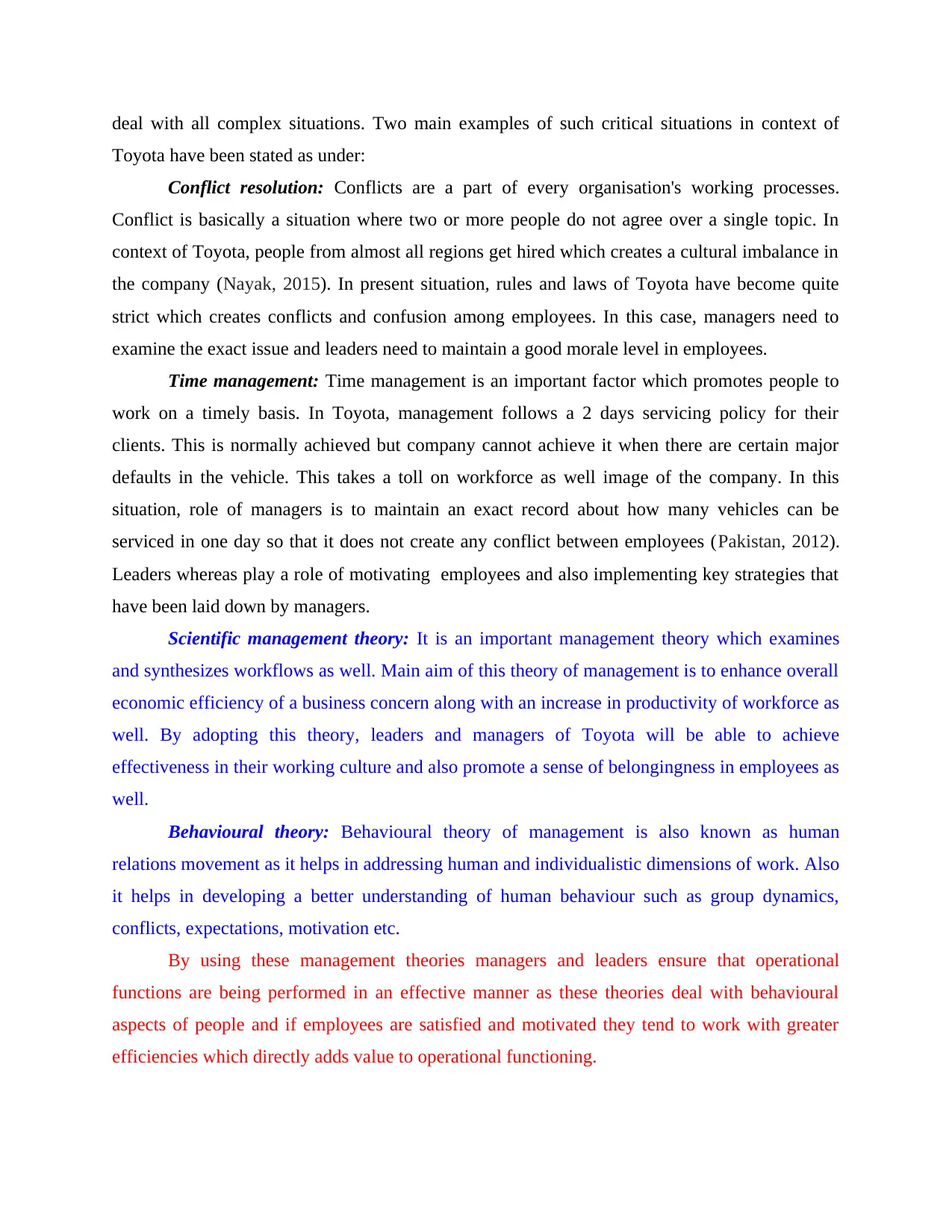
deal with all complex situations. Two main examples of such critical situations in context of
Toyota have been stated as under:
Conflict resolution: Conflicts are a part of every organisation's working processes.
Conflict is basically a situation where two or more people do not agree over a single topic. In
context of Toyota, people from almost all regions get hired which creates a cultural imbalance in
the company (Nayak, 2015). In present situation, rules and laws of Toyota have become quite
strict which creates conflicts and confusion among employees. In this case, managers need to
examine the exact issue and leaders need to maintain a good morale level in employees.
Time management: Time management is an important factor which promotes people to
work on a timely basis. In Toyota, management follows a 2 days servicing policy for their
clients. This is normally achieved but company cannot achieve it when there are certain major
defaults in the vehicle. This takes a toll on workforce as well image of the company. In this
situation, role of managers is to maintain an exact record about how many vehicles can be
serviced in one day so that it does not create any conflict between employees (Pakistan, 2012).
Leaders whereas play a role of motivating employees and also implementing key strategies that
have been laid down by managers.
Scientific management theory: It is an important management theory which examines
and synthesizes workflows as well. Main aim of this theory of management is to enhance overall
economic efficiency of a business concern along with an increase in productivity of workforce as
well. By adopting this theory, leaders and managers of Toyota will be able to achieve
effectiveness in their working culture and also promote a sense of belongingness in employees as
well.
Behavioural theory: Behavioural theory of management is also known as human
relations movement as it helps in addressing human and individualistic dimensions of work. Also
it helps in developing a better understanding of human behaviour such as group dynamics,
conflicts, expectations, motivation etc.
By using these management theories managers and leaders ensure that operational
functions are being performed in an effective manner as these theories deal with behavioural
aspects of people and if employees are satisfied and motivated they tend to work with greater
efficiencies which directly adds value to operational functioning.
Toyota have been stated as under:
Conflict resolution: Conflicts are a part of every organisation's working processes.
Conflict is basically a situation where two or more people do not agree over a single topic. In
context of Toyota, people from almost all regions get hired which creates a cultural imbalance in
the company (Nayak, 2015). In present situation, rules and laws of Toyota have become quite
strict which creates conflicts and confusion among employees. In this case, managers need to
examine the exact issue and leaders need to maintain a good morale level in employees.
Time management: Time management is an important factor which promotes people to
work on a timely basis. In Toyota, management follows a 2 days servicing policy for their
clients. This is normally achieved but company cannot achieve it when there are certain major
defaults in the vehicle. This takes a toll on workforce as well image of the company. In this
situation, role of managers is to maintain an exact record about how many vehicles can be
serviced in one day so that it does not create any conflict between employees (Pakistan, 2012).
Leaders whereas play a role of motivating employees and also implementing key strategies that
have been laid down by managers.
Scientific management theory: It is an important management theory which examines
and synthesizes workflows as well. Main aim of this theory of management is to enhance overall
economic efficiency of a business concern along with an increase in productivity of workforce as
well. By adopting this theory, leaders and managers of Toyota will be able to achieve
effectiveness in their working culture and also promote a sense of belongingness in employees as
well.
Behavioural theory: Behavioural theory of management is also known as human
relations movement as it helps in addressing human and individualistic dimensions of work. Also
it helps in developing a better understanding of human behaviour such as group dynamics,
conflicts, expectations, motivation etc.
By using these management theories managers and leaders ensure that operational
functions are being performed in an effective manner as these theories deal with behavioural
aspects of people and if employees are satisfied and motivated they tend to work with greater
efficiencies which directly adds value to operational functioning.

P3. Applying different models and theories of approach.
Leadership is a quite important process that infuses various qualities such as influencing
and guiding people. This aspect is used by leaders of Toyota for keeping morale of employees
stable and high. All they are able to focus on overall personality growth of an individual.
Various key leadership approaches have been stated as under:
Situational leadership theory: This leadership theory states that behaviour of leaders in
Toyota changes as per situations and need of the hour. Situational leadership theory is also
referred to as adaptive leadership style as leaders can adapt to any and every situations and also
motivate others to do the same (Situational Leadership. 2019). As per situational leadership there
are four styles in this approach named as selling, telling, participating and delegating. These
styles help in finding effective solutions to certain work based problems. Also employees are
provided set guidelines on which they have to work.
Strengths: This theory maintains a healthy work environment in Toyota due to flexibility
of rules. Also, no single leadership approach is followed it keep on modifying as per need of
situations.
Weaknesses: When a single leadership style is not opted, employees and leaders tend to
get confused which greatly hampers performance.
Contingency leadership theory: Contingency leadership approach is an important
leadership approach. Operations management refers to a process that mainly aims at reducing
wastes and thereby making optimum utilisation of resources (Parmar, 2014). It is a process that
is related to converting raw materials into finished products and services. It is an important tool
that helps in enhancing efficiency of business operations in Toyota. Also by using this approach
a balance between costs and revenue can be maintained. It is a leadership theory that examines
skills of leaders which they undertake while inspiring and motivating employees in Toyota.
According to this theory, a number of factors that form an integral part of this theory are leader
member relationship, positional power of employees and task structure of a business concern as
well. This theory also assesses the skills of employees as well.
Strengths: This leadership theory is greatly helpful in clarifying various complex
situations that may occur. This also leads to smooth functioning of a business concern.
Leadership is a quite important process that infuses various qualities such as influencing
and guiding people. This aspect is used by leaders of Toyota for keeping morale of employees
stable and high. All they are able to focus on overall personality growth of an individual.
Various key leadership approaches have been stated as under:
Situational leadership theory: This leadership theory states that behaviour of leaders in
Toyota changes as per situations and need of the hour. Situational leadership theory is also
referred to as adaptive leadership style as leaders can adapt to any and every situations and also
motivate others to do the same (Situational Leadership. 2019). As per situational leadership there
are four styles in this approach named as selling, telling, participating and delegating. These
styles help in finding effective solutions to certain work based problems. Also employees are
provided set guidelines on which they have to work.
Strengths: This theory maintains a healthy work environment in Toyota due to flexibility
of rules. Also, no single leadership approach is followed it keep on modifying as per need of
situations.
Weaknesses: When a single leadership style is not opted, employees and leaders tend to
get confused which greatly hampers performance.
Contingency leadership theory: Contingency leadership approach is an important
leadership approach. Operations management refers to a process that mainly aims at reducing
wastes and thereby making optimum utilisation of resources (Parmar, 2014). It is a process that
is related to converting raw materials into finished products and services. It is an important tool
that helps in enhancing efficiency of business operations in Toyota. Also by using this approach
a balance between costs and revenue can be maintained. It is a leadership theory that examines
skills of leaders which they undertake while inspiring and motivating employees in Toyota.
According to this theory, a number of factors that form an integral part of this theory are leader
member relationship, positional power of employees and task structure of a business concern as
well. This theory also assesses the skills of employees as well.
Strengths: This leadership theory is greatly helpful in clarifying various complex
situations that may occur. This also leads to smooth functioning of a business concern.
⊘ This is a preview!⊘
Do you want full access?
Subscribe today to unlock all pages.

Trusted by 1+ million students worldwide

Weaknesses: One major weakness or drawback of contingency theory is that is that
technology needs to altered with time and again and if skills of leaders are underdeveloped it
creates an issue as they cannot deal with critical situations effectively (Plesser and et. al., 2014).
System leadership theory: System leadership theory is useful when leaders wish to adopt
new policies and procedures for conducting business processes. This further helps in maintaining
effectiveness in working performance of employees. This leadership approach is greatly helpful
in improving production process of Toyota and employees also get a knowledge about which
goal has to be achieved in what time.
Strengths: System leadership approach helps in providing clarity about complex
situations. It also provides a framework for building and developing innovative ideas.
Weakness: It is a quite lengthy and time consuming process with lots of complexities.
Conclusions and Recommendations: As per the above stated leadership approaches it has been
stated that Toyota follows situational leadership style in its working and culture. Also it is
recommended that leaders should focus on keeping their employees motivated and satisfied. By
doing efficiency level of working culture in Toyota will rise at a quite rapid pace. All leaders
should motivate their employees for bringing about innovations and modifications in their
business practices.
TASK 3
P4. Key approaches to operations management and role played by managers and leaders.
Operations management refers to a process that mainly aims at reducing wastes and
thereby making optimum utilisation of resources. It is a process that is related to converting raw
materials into finished products and services. It is an important tool that helps in enhancing
efficiency of business operations in Toyota (Tristancho and Gutiérre, 2012).
As per organisational context two main operational activities of this business are production as
well as transportation of goods and services.
Production: An organisational function where raw materials are used and further
converted into finished goods and services. Production is a quite complex and lengthy process
that differs from organisation to organisation.
technology needs to altered with time and again and if skills of leaders are underdeveloped it
creates an issue as they cannot deal with critical situations effectively (Plesser and et. al., 2014).
System leadership theory: System leadership theory is useful when leaders wish to adopt
new policies and procedures for conducting business processes. This further helps in maintaining
effectiveness in working performance of employees. This leadership approach is greatly helpful
in improving production process of Toyota and employees also get a knowledge about which
goal has to be achieved in what time.
Strengths: System leadership approach helps in providing clarity about complex
situations. It also provides a framework for building and developing innovative ideas.
Weakness: It is a quite lengthy and time consuming process with lots of complexities.
Conclusions and Recommendations: As per the above stated leadership approaches it has been
stated that Toyota follows situational leadership style in its working and culture. Also it is
recommended that leaders should focus on keeping their employees motivated and satisfied. By
doing efficiency level of working culture in Toyota will rise at a quite rapid pace. All leaders
should motivate their employees for bringing about innovations and modifications in their
business practices.
TASK 3
P4. Key approaches to operations management and role played by managers and leaders.
Operations management refers to a process that mainly aims at reducing wastes and
thereby making optimum utilisation of resources. It is a process that is related to converting raw
materials into finished products and services. It is an important tool that helps in enhancing
efficiency of business operations in Toyota (Tristancho and Gutiérre, 2012).
As per organisational context two main operational activities of this business are production as
well as transportation of goods and services.
Production: An organisational function where raw materials are used and further
converted into finished goods and services. Production is a quite complex and lengthy process
that differs from organisation to organisation.
Paraphrase This Document
Need a fresh take? Get an instant paraphrase of this document with our AI Paraphraser

Transportation: After the goods are manufactured they need to be sent from one place to
another. This process of travelling is referred to as transportation. Also by using this approach a
balance between costs and revenue can be maintained.
Role played by leaders:
A leader has utmost authority in Toyota and plays an all pervasive function. Leaders also
motivate employees in Toyota which makes them function with greater efficiency. Leaders in Toyota have a quite charismatic personality. This factor helps them in
influencing and attracting employees whenever they need any kind of support or expect
coordination. Also, it is said that leaders can use interpersonal skills for the same.
Role played by managers:
Main function of managers in Toyota is to examine everyday functionality of employees
in Toyota thereby focussing on growth and development. For this, managers may even
need to frame certain rules or policies for betterment of employees. Main duty of managers in Toyota is to check whether every task assigned is completed
within its specified time limit or not
Various key approaches of operations management have been specified as under:
Six sigma: Six sigma is an important approach that uses statistical tools for elimination of
errors or defects that may be occurring in production process. This helps managers of Toyota in
performance appraisal of employees and also raising productivity standards . Six Sigma uses a
number of statistical tools that aims at reducing or eliminating variances from a set standard
production process. Six sigma is further classified into two broad categories namely DMAIC and
DMADV. This approach helps managers so that they can evaluate performance of employees
and also raise their profitability.
Just in Time approach: Just in time is an important inventory management approach that
helps leaders and managers of Toyota in their overall inventory management. JIT also undertakes
lean methodology for enhancing performance level of employees and developing their area of
expertise. Just in time approach mainly focusses on reduction or elimination of cost of inventory
management also reduces chances of dead stock . This is a cost effective approach as it
eliminates any overhead costs or expenses.
Total quality management: Total quality management aims at retaining customers as
well as maintaining effective quality standards at some point of time. It also helps in long term
another. This process of travelling is referred to as transportation. Also by using this approach a
balance between costs and revenue can be maintained.
Role played by leaders:
A leader has utmost authority in Toyota and plays an all pervasive function. Leaders also
motivate employees in Toyota which makes them function with greater efficiency. Leaders in Toyota have a quite charismatic personality. This factor helps them in
influencing and attracting employees whenever they need any kind of support or expect
coordination. Also, it is said that leaders can use interpersonal skills for the same.
Role played by managers:
Main function of managers in Toyota is to examine everyday functionality of employees
in Toyota thereby focussing on growth and development. For this, managers may even
need to frame certain rules or policies for betterment of employees. Main duty of managers in Toyota is to check whether every task assigned is completed
within its specified time limit or not
Various key approaches of operations management have been specified as under:
Six sigma: Six sigma is an important approach that uses statistical tools for elimination of
errors or defects that may be occurring in production process. This helps managers of Toyota in
performance appraisal of employees and also raising productivity standards . Six Sigma uses a
number of statistical tools that aims at reducing or eliminating variances from a set standard
production process. Six sigma is further classified into two broad categories namely DMAIC and
DMADV. This approach helps managers so that they can evaluate performance of employees
and also raise their profitability.
Just in Time approach: Just in time is an important inventory management approach that
helps leaders and managers of Toyota in their overall inventory management. JIT also undertakes
lean methodology for enhancing performance level of employees and developing their area of
expertise. Just in time approach mainly focusses on reduction or elimination of cost of inventory
management also reduces chances of dead stock . This is a cost effective approach as it
eliminates any overhead costs or expenses.
Total quality management: Total quality management aims at retaining customers as
well as maintaining effective quality standards at some point of time. It also helps in long term
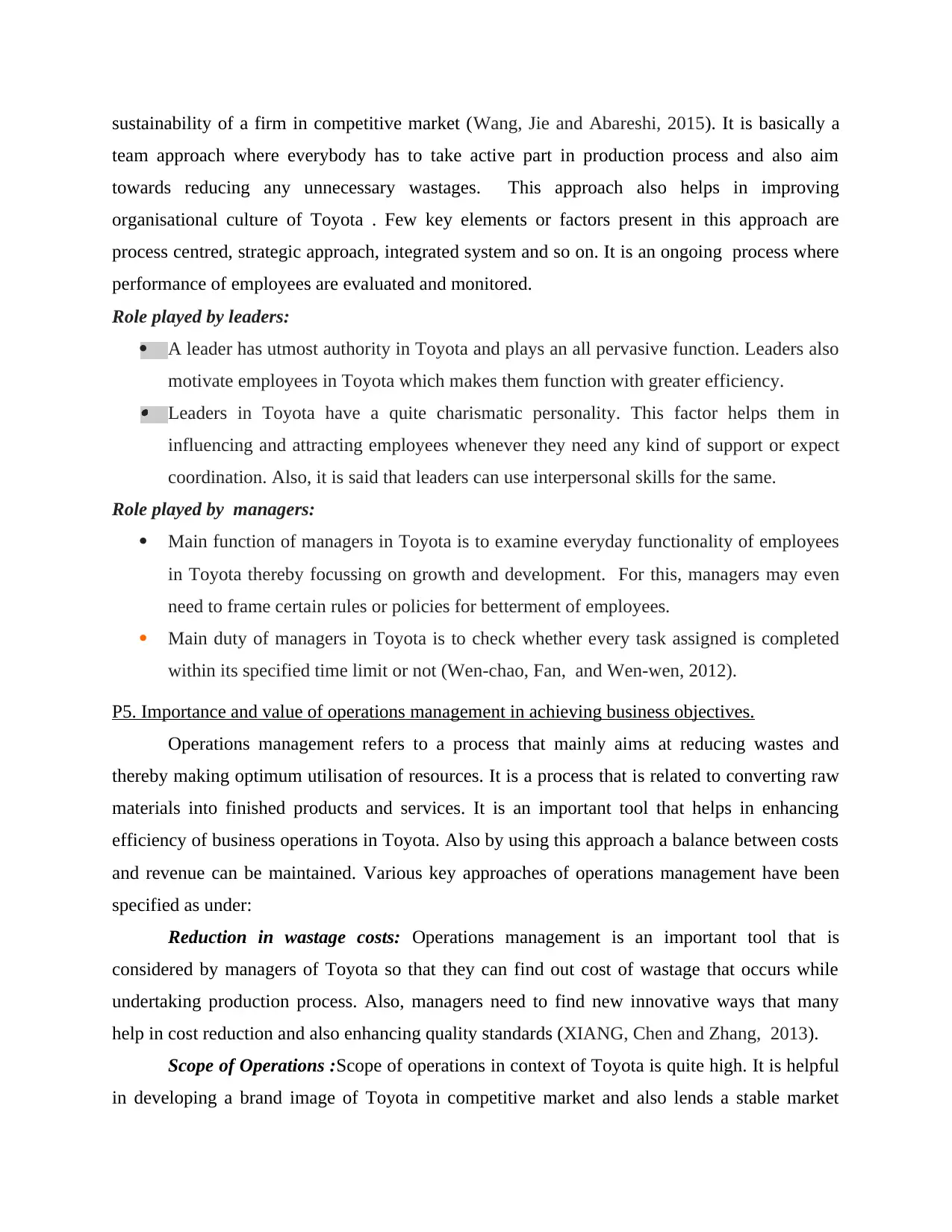
sustainability of a firm in competitive market (Wang, Jie and Abareshi, 2015). It is basically a
team approach where everybody has to take active part in production process and also aim
towards reducing any unnecessary wastages. This approach also helps in improving
organisational culture of Toyota . Few key elements or factors present in this approach are
process centred, strategic approach, integrated system and so on. It is an ongoing process where
performance of employees are evaluated and monitored.
Role played by leaders:
A leader has utmost authority in Toyota and plays an all pervasive function. Leaders also
motivate employees in Toyota which makes them function with greater efficiency. Leaders in Toyota have a quite charismatic personality. This factor helps them in
influencing and attracting employees whenever they need any kind of support or expect
coordination. Also, it is said that leaders can use interpersonal skills for the same.
Role played by managers:
Main function of managers in Toyota is to examine everyday functionality of employees
in Toyota thereby focussing on growth and development. For this, managers may even
need to frame certain rules or policies for betterment of employees.
Main duty of managers in Toyota is to check whether every task assigned is completed
within its specified time limit or not (Wen-chao, Fan, and Wen-wen, 2012).
P5. Importance and value of operations management in achieving business objectives.
Operations management refers to a process that mainly aims at reducing wastes and
thereby making optimum utilisation of resources. It is a process that is related to converting raw
materials into finished products and services. It is an important tool that helps in enhancing
efficiency of business operations in Toyota. Also by using this approach a balance between costs
and revenue can be maintained. Various key approaches of operations management have been
specified as under:
Reduction in wastage costs: Operations management is an important tool that is
considered by managers of Toyota so that they can find out cost of wastage that occurs while
undertaking production process. Also, managers need to find new innovative ways that many
help in cost reduction and also enhancing quality standards (XIANG, Chen and Zhang, 2013).
Scope of Operations :Scope of operations in context of Toyota is quite high. It is helpful
in developing a brand image of Toyota in competitive market and also lends a stable market
team approach where everybody has to take active part in production process and also aim
towards reducing any unnecessary wastages. This approach also helps in improving
organisational culture of Toyota . Few key elements or factors present in this approach are
process centred, strategic approach, integrated system and so on. It is an ongoing process where
performance of employees are evaluated and monitored.
Role played by leaders:
A leader has utmost authority in Toyota and plays an all pervasive function. Leaders also
motivate employees in Toyota which makes them function with greater efficiency. Leaders in Toyota have a quite charismatic personality. This factor helps them in
influencing and attracting employees whenever they need any kind of support or expect
coordination. Also, it is said that leaders can use interpersonal skills for the same.
Role played by managers:
Main function of managers in Toyota is to examine everyday functionality of employees
in Toyota thereby focussing on growth and development. For this, managers may even
need to frame certain rules or policies for betterment of employees.
Main duty of managers in Toyota is to check whether every task assigned is completed
within its specified time limit or not (Wen-chao, Fan, and Wen-wen, 2012).
P5. Importance and value of operations management in achieving business objectives.
Operations management refers to a process that mainly aims at reducing wastes and
thereby making optimum utilisation of resources. It is a process that is related to converting raw
materials into finished products and services. It is an important tool that helps in enhancing
efficiency of business operations in Toyota. Also by using this approach a balance between costs
and revenue can be maintained. Various key approaches of operations management have been
specified as under:
Reduction in wastage costs: Operations management is an important tool that is
considered by managers of Toyota so that they can find out cost of wastage that occurs while
undertaking production process. Also, managers need to find new innovative ways that many
help in cost reduction and also enhancing quality standards (XIANG, Chen and Zhang, 2013).
Scope of Operations :Scope of operations in context of Toyota is quite high. It is helpful
in developing a brand image of Toyota in competitive market and also lends a stable market
⊘ This is a preview!⊘
Do you want full access?
Subscribe today to unlock all pages.

Trusted by 1+ million students worldwide
1 out of 18
Related Documents
Your All-in-One AI-Powered Toolkit for Academic Success.
+13062052269
info@desklib.com
Available 24*7 on WhatsApp / Email
![[object Object]](/_next/static/media/star-bottom.7253800d.svg)
Unlock your academic potential
Copyright © 2020–2025 A2Z Services. All Rights Reserved. Developed and managed by ZUCOL.





